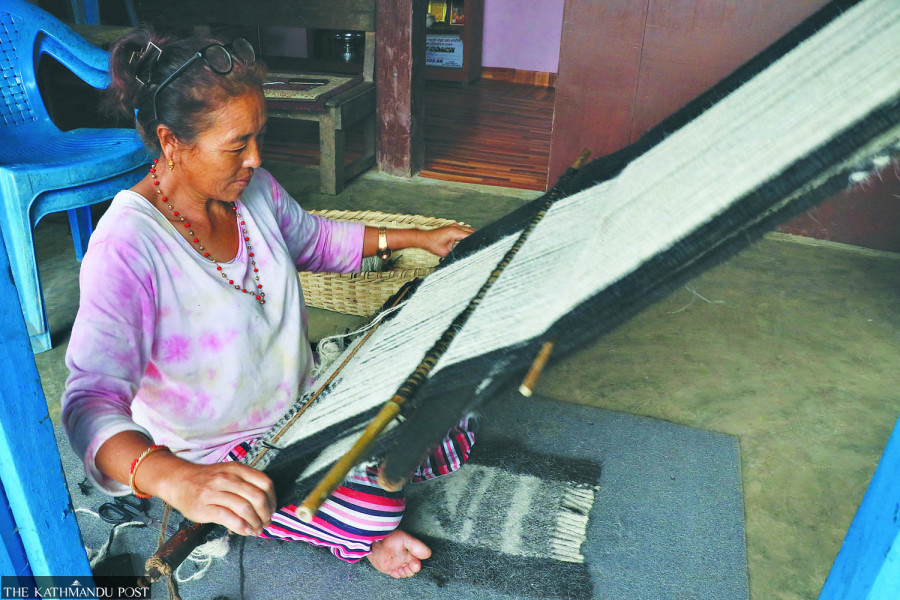Money
Traditional carpet weavers fear their skill will die out
The local government has not accorded priority to sheep farming to protect the centuries-old profession, they say.
Dambar Singh Rai
Khadga Kumari Gurung of Hauchur Chapkharka in Rawa Besi Rural Municipality-6 has been weaving radi and pakhi–traditional woollen mats and blankets–for nearly four decades.
“I started weaving the products from sheep’s wool from the age of 17,” said Gurung, now 55, from Khotang district in eastern Nepal.
“I used to earn around Rs250,000 a year. It was enough to pay for my household expenses and children’s education.”
Pashupati Gurung, also from Chapkharka, has been weaving woollen blankets and mats for the last 30 years.
Her products fetch Rs1,500 to Rs15,000 apiece, depending on the size and quality.
“I learnt the skill of weaving from my mother at an early age,” said Gurung.
Like Khadga Kumari and Pashupati, a majority of women in the Gurung community of Khotang have been making woollen mats and blankets on handlooms. They also rear sheep to produce wool.
Most of the weavers live in Rawa Besi Rural Municipality, Diktel Rupakot Majhuwagadhi Municipality, Aiselukharka Rural Municipality and Kepilasgadhi Rural Municipality.
Apart from the Gurung community, women from the Rai, Bhujel and Magar communities also weave various products from sheep wool.
These artisans are concerned that they may be the last of a dying breed as the youths are not interested in learning the skill.
“The young generation is no longer attracted by this profession. My daughters and daughters-in-law are reluctant to continue the profession,” said Leela Gurung.
"The new generation doesn’t want to learn the traditional skills," said Nirmaya Gurung of Nerpa in Diktel Rupakot Majhuwagadhi Municipality.
“This is because of the diminishing sheep population and lack of modern weaving equipment.”
The local government has not accorded priority to sheep farming to protect the centuries-old profession, they say.
“Sheep farming has deep ties with the Gurung culture. But the number of sheep rearers is decreasing,” said Mohan Gurung. “Because of this, there’s a scarcity of good quality wool. The quality of the wool directly impacts the demand and prices in the market.”
Currently, there are 29 flocks of sheep in Khotang. There are few grazing areas too.
Sheep farmers complain that the high fees charged by the local community forests to graze sheep, epidemics, wildlife attacks and lack of adequate veterinarians are other reasons behind the decreasing flocks.
The sheep herders drive their flocks to the lowlands during the winter and to the high hills in the summer. During this annual movement, they graze their sheep in 47 community forests in the district.
Some community forests charge Rs50 per sheep while others charge a lump-sum Rs500 to allow the flock to enter the grasslands.
“Half of our earning goes to pay grazing fees to the community forests,” said Rai.
The farmers also complain that they face issues when claiming compensation from insurance companies when their sheep die.
“Some time ago, I lost 52 sheep all at once. I had a hard time claiming compensation. But non-farmers are enjoying the subsidies and other benefits meant for farmers,” he said.
The local government insists that it has been working to conserve the indigenous skill of weaving woollen mats and carpets.
Kaushila Gurung, deputy chief of Rawa Besi Rural Municipality, said that the local government allocated Rs500,000 in the last fiscal year to distribute 50 spinning wheels and 170 wool combs to local female entrepreneurs.
Women of Hauchaur, Phthalate, Khubhinde, Dumre Dharapani and Dubekol have distributed the instruments.
“Many locals are compelled to give up the profession due to the scarcity of appropriate tools. To address this issue, we have distributed these tools to be used by weavers on a shared basis,” said Kaushila Gurung.
“More tools and equipment will be provided to the women of other communities such as Rai, Bhujel and Magar who are also engaged in the profession. They will help to uplift their livelihood.”




 12.12°C Kathmandu
12.12°C Kathmandu













%20(1).jpg&w=300&height=200)
